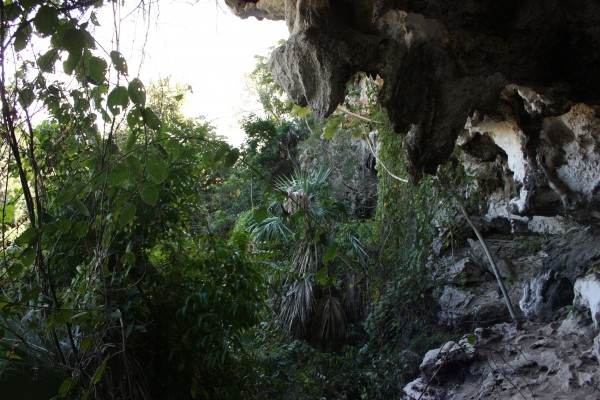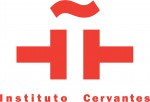
A convergence between the literary and the visual, artist Aurora De Armendi and scholar Adriana Méndez Rodenas have produced a limited-edition artist’s book honoring Ana Mendieta’s Rupestrian Sculptures, a series of low-relief sculptures created in 1981 at the Escaleras de Jaruco, a national park outside Havana. The low-relief sculptures, directly carved on the limestone walls of a cave, were meant to evoke the belief system of the indigenous Taíno people of Cuba. Mendieta identified with the Taínos as a way to grapple with her own exiled condition. Her series traces reminiscences of Taíno creation stories while refashioning ancestral female deities. The most most intimate and revealing of her works, the Rupestrian Sculptures mark a threshold in Mendieta’s earth/body art. Integral to the
process of this book, Méndez Rodenas and De Armendi revisited the site in 2012.
With the project concept, images, printing and binding by De Armendi and an interdisciplinary scholarly essay by Méndez Rodenas, the authors have successfully joined ethnographic and artistic approaches in reinterpreting Mendieta’s series as it appears thirty years later. Their act
of recovery honors the art and legacy of Ana Mendieta and is meant as a testimony of Cuban cultural memory. The book will have its New York City launching on this occasion, featuring an illustrated presentation and a conversatorio with the audience.
INSTITUTO CERVANTES 211 East 49th Street, bet. 2nd & 3rd Aves., NYC
FREE ADMISSION for MEMBERS of CCCNY or IC
PLEASE RSVP at: info@cubanculturalcenter.org
 Ana Mendieta (1948-1985) was a Cuban born artist whose practice included sculpture, performance, photography, film, video, drawing and site-specific installation. Her works refer to cultural, religious and artistic influences, from Afro-Cuban and indigenous Caribbean traditions to Catholicism, to conceptual art and post-minimalism. Working from the early 1970s through to the mid-1980s, Mendieta pioneered themes such as displacement, identity politics and the female body, which continue to forefront the work of major contemporary artists today.
Ana Mendieta (1948-1985) was a Cuban born artist whose practice included sculpture, performance, photography, film, video, drawing and site-specific installation. Her works refer to cultural, religious and artistic influences, from Afro-Cuban and indigenous Caribbean traditions to Catholicism, to conceptual art and post-minimalism. Working from the early 1970s through to the mid-1980s, Mendieta pioneered themes such as displacement, identity politics and the female body, which continue to forefront the work of major contemporary artists today.
 Aurora De Armendi is an interdisciplinary artist and teacher, working in print media, video and, most recently, in the form of a book, exploring ideas of displacement, collective memory and how we inhabit or imagine both identity and place. Aurora received her BFA from The Cooper Union and her MFA from The University of Iowa. She participated in the AIM program at The Bronx Museum and was a fellow at The Center for Book Arts, New York in 2013. In 2016, she completed artist residencies at Anderson Ranch Arts Center and Jamaica Flux and was a finalist for the Cintas Foundation Fellowship showing her work at the MDCC Museum at the Freedom Tower in Miami. Her work as been included on group exhibitions at the Bronx Biennial in Wave Hill Garden, the International Print Center in New York, The Center for Book Arts in New York as well as in cities in the United States, Iceland, Hungary, Argentina, Cuba among others.
Aurora De Armendi is an interdisciplinary artist and teacher, working in print media, video and, most recently, in the form of a book, exploring ideas of displacement, collective memory and how we inhabit or imagine both identity and place. Aurora received her BFA from The Cooper Union and her MFA from The University of Iowa. She participated in the AIM program at The Bronx Museum and was a fellow at The Center for Book Arts, New York in 2013. In 2016, she completed artist residencies at Anderson Ranch Arts Center and Jamaica Flux and was a finalist for the Cintas Foundation Fellowship showing her work at the MDCC Museum at the Freedom Tower in Miami. Her work as been included on group exhibitions at the Bronx Biennial in Wave Hill Garden, the International Print Center in New York, The Center for Book Arts in New York as well as in cities in the United States, Iceland, Hungary, Argentina, Cuba among others.
Adriana Méndez Rodenas is Professor of Caribbean and Latin American Literatures in the Department of Romance Languages and Literatures at the University of Missouri, where she also directs the Afro-Romance Institute. She has written amply on Cuban literature, including her signature book, Gender and Nationalism in Colonial Cuba: The Travels of Santa Cruz y Montalvo, Condesa de Merlin (1998), followed by a critical edition of Merlin’s Viaje a la Habana (2009). Her research on travel writing resulted in Transatlantic Travels to Nineteenth Century Latin America: European Women Pilgrims ( 2014), and Review—Literature and the Arts of the Americas 84 (2012), dedicated to “Women Travelers to Latin America.” She has won a number of prestigious grants and awards from the NEH (National Endowment for the Humanities), the Fulbright Distinguished Chair of American Studies at Uppsala University (2008-2009), and, most recently, a research fellowship at the Huntington Library in San Marino, California.
at the University of Missouri, where she also directs the Afro-Romance Institute. She has written amply on Cuban literature, including her signature book, Gender and Nationalism in Colonial Cuba: The Travels of Santa Cruz y Montalvo, Condesa de Merlin (1998), followed by a critical edition of Merlin’s Viaje a la Habana (2009). Her research on travel writing resulted in Transatlantic Travels to Nineteenth Century Latin America: European Women Pilgrims ( 2014), and Review—Literature and the Arts of the Americas 84 (2012), dedicated to “Women Travelers to Latin America.” She has won a number of prestigious grants and awards from the NEH (National Endowment for the Humanities), the Fulbright Distinguished Chair of American Studies at Uppsala University (2008-2009), and, most recently, a research fellowship at the Huntington Library in San Marino, California.
This event presented in celebration of Women’s History Month and is co-sponsored by Instituto Cervantes

With press coverage by
